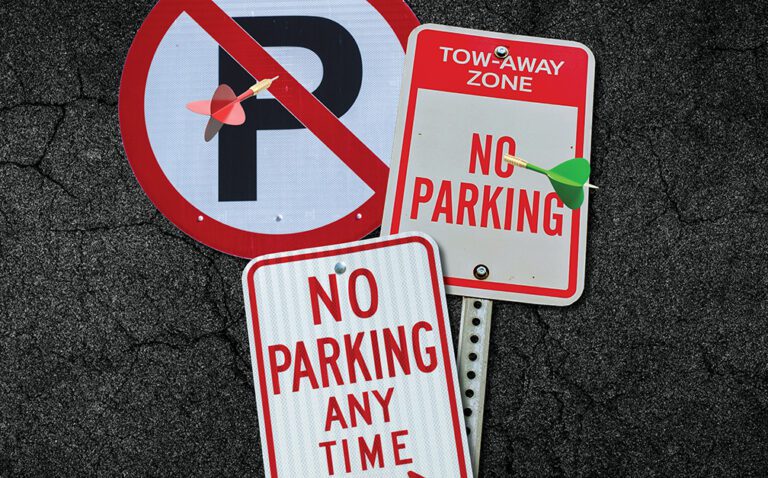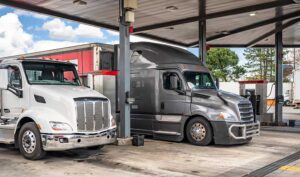A lack of safe, secure, and affordable truck parking across the U.S. is an ongoing crisis, according to many in the industry.
In recent years, lawmakers have attempted to tackle the problem at all levels, but Washington moves notoriously slowly — while drivers aim to get their loads to their destinations on time and as safely as possible.
The issue was first brought to the forefront in 2009 after the murder of truck driver Jason Rivenburg, who was attacked and robbed while parked at an abandoned fuel station after searching unsuccessfully for a safer spot.
In October 2012, “Jason’s Law” was enacted in an effort to address the problem. The law “requires a survey of each state to evaluate parking, commercial motor vehicle traffic volumes, and to derive a system of metrics to measure truck parking in each State.” Unfortunately, most would agree this has done little to correct the problem.
Statistics show there were approximately 313,000 truck parking spaces in the U.S. as of October 2022. In contrast, it’s estimated that there are more than 3.5 million truck drivers in the U.S., with hundreds of thousands of those drivers on the highways at any given time. According to data from the Truckload Carriers Association, there is just one truck parking space for every 11 drivers.
In recent years, lawmakers have attempted to tackle the problem at all levels, but Washington moves notoriously slowly — while drivers aim to get their loads to their destinations on time and as safely as possible.
“Truck parking shortages are a national safety concern,” The Federal Highway Administration (FHWA) states on its web page. “Commercial truck drivers need access to safe, secure, and accessible truck parking. With the projected growth of truck traffic, the demand for truck parking will continue to outpace the supply of public and private parking facilities and will only exacerbate the truck parking problems experienced in many regions.”
Most in the trucking industry would agree that it’s a no-brainer: An inadequate supply of truck parking spaces can result in negative consequences. Tired truck drivers may continue to drive because they have difficulty finding a place to park for rest, or they may choose to park in unsafe (and sometimes illegal) locations, such as on the shoulder of the road, along interstate exit ramps, or on vacant lots.
It’s a complaint that’s been frequently discussed, but a quick poll of drivers and motor carriers would indicate that not enough has been done to remedy the problem. Lawmakers are hoping 2023 can be the year they can effect a change through bipartisan legislation.
The legislation itself isn’t new. In March 2021, the bipartisan Truck Parking Safety Improvement Act ((H.R. 2187) was introduced in the House by Reps. Mike Bost (R-IL) and Angie Craig (D-MN) in 2022 in the U.S. House of Representatives. The House Truck Parking Safety Improvement Act was passed by the House Committee on Transportation and Infrastructure. The bill was amended and recommended for passage by the House Committee on Transportation and Infrastructure on December 13, 2022.
The act would invest $755 million in the creation of new truck parking spaces. Funding would be awarded on a competitive basis, and applicants would be required to submit detailed proposals to the U.S. Department of Transportation (DOT). The primary focus would be to construct new truck parking facilities and convert existing weigh stations and rest areas into functional parking areas for truck drivers.
Meanwhile, the bill was introduced in the Senate (S. 5169) on December 1, 2022, by Sens. Cynthia Lummis (R-WY) and Mark Kelly (D-AZ) and referred to the Committee on Environment and Public.
Another piece of legislation that includes provisions for safe, accessible truck parking is the HR. 471, the Safer Highways and Increased Performance for Interstate Trucking Act (popularly known as the SHIP IT Act), was introduced in Congress on January 24 by Reps. Dusty Johnson (R-SD) and Jim Costa (D-CA). The bill was immediately referred to the House Transportation and Infrastructure Committee (T&I); on February 1, it was passed to T&I’s Subcommittee on Highways and Transit.
Not every response to these proposed bills has been positive. For example, the International Brotherhood of Teamsters was quick to voice opposition to the SHIP IT Act.
“Supply chain challenges and bottlenecks over the last few years have laid bare a number of critical issues in the trucking industry, including the prevalence of poor working conditions, rampant and illegal misclassification of drivers under labor law, and the scourge of fly-by-night contracted and subcontracted motor carriers,” Teamsters General President Sean M. O’Brien said in a letter to the U.S. House of Representatives. “H.R. 471 looks to wrong and dangerous short-term ‘solutions’ to the very real legal and economic issues present in commercial trucking.”
Meanwhile, drivers continue to struggle to find safe, secure parking without violating hours-of-service regulations.
This article originally appeared in the March/April 2023 edition of Truckload Authority, the official publication of the Truckload Carriers Association.
Joseph Price has been a journalist for almost two decades. He began in community media in 2005 and has since worked at media outlets in Virginia and Arkansas. He is also a commercial drone pilot and video editor. He hosts a weekly community radio show focused on goth, metal and industrial music that airs Wednesday evenings at 6 p.m. at www.kuhsradio.org.













